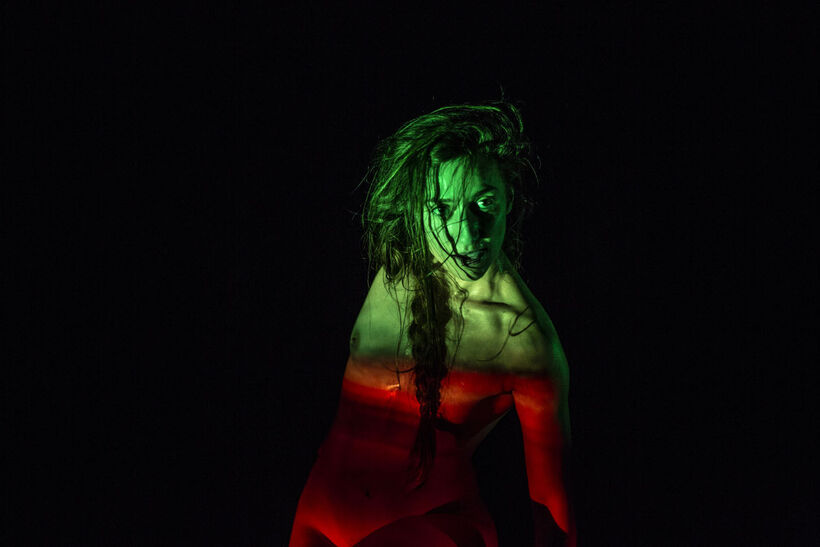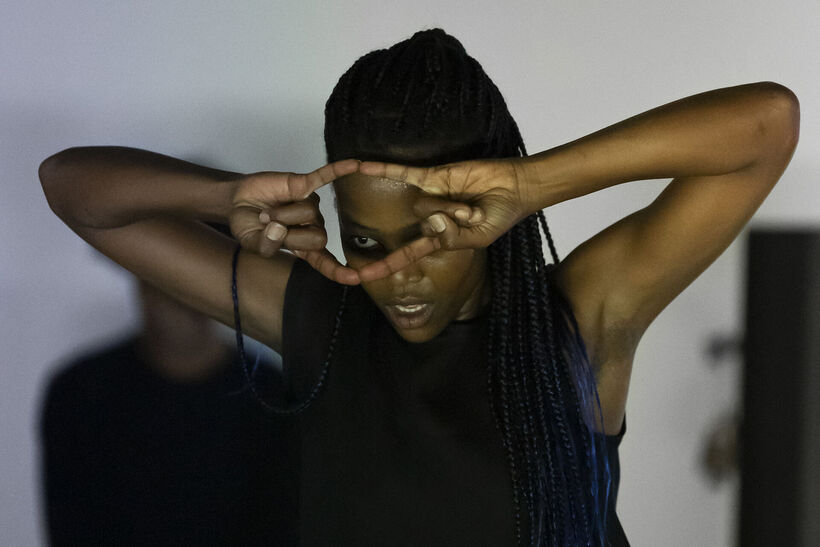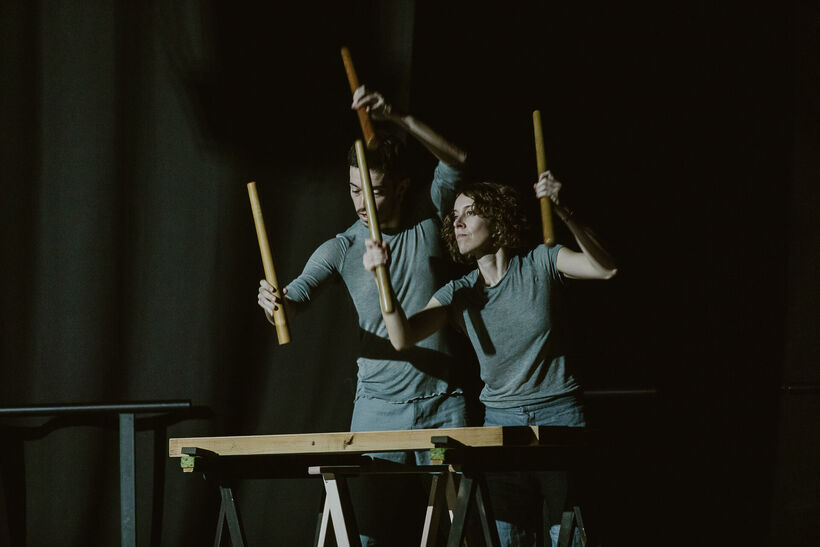Brigittines International Festival 2024 - A Dance Festival with Poetic Ambitions
According to artistic director Patrick Bonté, this year’s International Festival at Les Brigittines in Brussels is a “whirlwind of perceptions”, where “powerful emotion arises from drifting zones, where the line between the narrative and the imaginative becomes indistinguishable.” After attending five performances during the last week, I can testify that the artistic lineup offers plenty of drifting moments of uncertainty that certainly leave much to the imagination.
Implied in the festival’s credo, inspired by Icelandic novelist Jón Kalman Stefánsson’s poetic prose, and detectable within the performance selection, there lies a tendency towards an “old-fashioned notion of contemporary dance”, as one might call it. It does admittedly feel refreshing to delve into performances wedded to the strict exploration of the dancing body at a time when choreographic Gesamtkunst has moved the artform to different theoretical and practical frameworks. These impressions seem to be par for the course for Les Brigittines festival. I recently spoke with some cultural workers I know in Belgium about the festival, and their opinions were mixed: “Les Brigittines? That's a bit old school,” one said. Another commented, “Les Brigittines is so eclectic—you never really know what to expect.” What is certain is that Les Brigittines, a “playhouse for movement”, is a rather captivating architectural venue, consisting of a Flemish Renaissance chapel that dates from 1663 and a parallel contemporary mirror made out of glass and steel from 2007. Here, we find the Mezzo Hall, which provides a more straightforward black-box experience in contrast to the chapel, where the sound reverberates between the bare stone walls all the way up to the sky-high wooden ceiling.
A Slow Start
The Belgian premiere of Le quatrième pas se fait dans la nuit by Compagnie Euphorbia/Anne-Sophie Lancelin is a curious spectacle, shrouded in darkness and ominous music that slowly distorts the bodies of the three performers: Aurélie Berland, Anne-Sophie Lancelin, and Carole Quettier. As if from a vaguely remembered dream, the dancers, clad in black tank tops and trousers, move with a serpentine, undulating fluidity with their gazes deliberately locked away from the audience. A sense of total alienation persists throughout the performance. Envisioned as a collaboration between composer Lucac Fagin and photographer Nina-Floe Hernandez, both music and lighting play a crucial role in altering the viewer’s perception, contributing to the growing unease. The dancers appear to be trapped in their own nightmarish world of incoherent associations, manifesting in unsettling images: spiders crawling across the floor, a floating head projected in the background. Time dilutes as the performers navigate the stage with bent knees and constrained leg movements, their hands often obscuring their faces in a gesture of refusal. Unfortunately, the climactic moment, when the dancers remove their hairpins, letting their hair fall over their faces, was not quite the terrifying finale it was building up to. As I drowsily exit onto the streets below, the performance soon feels more like a faint dream than a gripping nightmare, the kind that slips through your fingers the moment you wake up. Like a David Lynch film gone wrong, it ultimately ends up being much ado yet little substance.
Another Belgian premiere is Sujets by Compagnie Sylvain Huc, remade this year after first seeing the light of day in 2018. It starts in silence, with five white, nude, muscular performers—two women and three men—posing in a tableau reminiscent of a Renaissance painting or Greek sculpture. As the piece progresses, the performers move slowly, their bodies intertwining and shifting in a series of configurations that emphasise raw physicality over traditional dance. The interaction between Fabrice Planquette’s lighting, Alessandro Cortini’s throbbing music, and the performers themselves creates a hypnotic atmosphere, drawing the viewer into a contemplative state where time seems to stretch out, similarly to the previous performance.
As their genitals swirl over their bodies like separate organisms, the piece drags on with various constellations of bodies, a lot of gazing, leaping, and an occasional ballet jump. Despite the strong visual and sensory elements, the tedious body explorations in between curb my enthusiasm. The nudity, which initially seems to promise a deeper exploration of the body, ultimately adds little to the overall experience. The performers’ intense gazes at the audience, seemingly aimed at provocation, end up in yet-another-showcase of something we’ve all seen before. In the end, while the performance has moments of intrigue and beauty, the whole amounts to a dreary exercise in spectator endurance, leaving you with nothing but a profound sense of artistic fatigue.
Revolutions of Time
Entering the dark Mezzo Hall for the third performance, I worried that the fatigue would spill over. According to the show notes, in REvolutions 2349, dancer Danielle Allouma would “pull off the feat of spinning on herself for what seems like an infinite amount of time.” Very well… Yet, unlike the previous self-absorbed display of bodies, choreographer Arco Renz and Allouma seem to have created something quite special in their collaboration: an act of extreme, uncompromising repetition that moves dynamically and with an intense presence. The performance begins with Allouma slowly emerging into the dim light, spinning within a small, defined square. Covered in a minimalist, skin-coloured bodysuit, her repetitive, methodical rotations take on an almost meditative quality, amplified by a pulsating score that lulls us into a magnetic state. With each turn, Allouma subtly shifts her movements—her arms rise, her head tilts, and the lighting morphs from soft hues to intense flashes, creating a fragmented visual experience where the dancer’s form is never fully captured. A real “whirlwind of perceptions!”
The striking physical feat of an hour of continuous high-speed rotation is worth the entrance fee alone. As the clock’s hour hand closes in on its own full rotation, the dancer gathers herself for a final burst of energy— draped in a metal-like square-web, her long hair flowing, her limbs spinning wildly. Yet by now, it feels like one turn too many. In a performance exploring the circular, maybe it is a mathematical necessity that the grand finale remain elusive. The spinning contour of the infatigable Allouma caught in a web of her own making is a fitting image of the festival, where great beauty and artistic virtuosity just cannot help basking in their own brilliance for a just little too long.
In contrast to all the other performances reviewed, Dorothée Munyaneza’s Moi, Toi, Tituba… carries powerful socio-political heft. Inspired by Maryse Condé's I, Tituba, Black Witch of Salem and philosopher Elsa Dorlin's writings, Munayenza reimagines the silenced histories of Black women. The performance reminds me of Saidiya Hartman’s concept of “critical fabulation”: a speculative narrative that works on embodying the trauma and resistance of Black counter-history. Munyaneza’s choreography, set to Khyam Allami's unsettling electronic score, develops as a ritualistic summoning, her sharp movements and defiant gaze asking uncomfortable questions of the (predominantly white) audience at Les Brigittines.
While the performance begins with evocative power, its strength falters in the second half. Munyaneza’s physical intensity and the haunting soundscape lose their impact as the performer disconnects from the audience while communicating with ghostly voices emanating from the speakers. The political stakes remain clear and are made explicit in a subsequent monologue. However, the show turns out to be almost didactic, as connections between the emotional, physical, and conceptual are lost. Nonetheless, in its bold attempt to confront colonial history, offering a vision of resistance through the reclamation of silenced voices, Moi, Toi, Tituba… leaves a lasting impression.
Closing the Circle
The festival closes with a bang – or rather a symphony of percussion woodblocks. In another Belgian premiere, we are acquainted with the Txalaparta, a traditional Basque drumming instrument and the title of the latest piece by the Basque dance company Kukai Dantza. This performance, directed by Jesús Rubio Gamo, is an uncompromising and grandiose spectacle blending pre-Christian Basque and Sardinian carnival rituals with contemporary dance compositional and kinetic practices. The frenetic rhythm of four txalapartas set in each corner of the stage reverberates between the tall stone walls of the chapel, creating a rare, almost primal energy that fills the space with sound and movement. The seven performers take turns bashing out intricate rhythms on the instrument and perform a circle of increasingly complex and fast-paced choreographed scenes. The rhythms seem uncontrolled, yet as the circle repeats itself, we understand it is meticulously composed and choreographed.
As the performance progresses, the dancers engage in moments of contact choreographies imbued with intense theatricality. Yet, it is the Basque folk-dance movements such as jumps, scissor kicks, and leg-slapping, introduced around the mid-way point, that truly add to the vibrant, almost celebratory energy of the txalaparta instrument. The dancers embody the themes of spring, renewal, and fertility with reckless abandon, and the audience is moved to let go in this emotional roller-coaster. The performance concludes just as the powerful juxtaposition between the wild physicality of the coarse instrument and the precision of the choreography reaches its zenith. It is a truly arresting performance.
The analogy to Jon Kalman Stefansson’s beautiful yet (at times) overwrought poetic prose holds true through the festival. Director Bonté pleads for art that brings us away from the “zeitgeist [marked by the] sterility of identity poles and the pleas for reassurance that would have us believe that creativity is clean-cut, imbued with morality and self-righteousness.” Against the banality of our contemporary existence, La Brigittines present a stage that “searches for itself in the sensible and the unusual, and in the wonder of living.” While these are lofty aspirations indeed, it must be concluded that the festival makes good on its promise. Like their forebears from the 1990s, several of these displays of dance “for its own sake” could easily be accused of indulging in self-contained solipsism. Yet, the irresistible quality of the performances, and the addition of just enough social dynamism to keep the show moving means the festival – for the most part – represents a breath of fresh air. Sometimes, it seems, a healthy dose of old-school avantgarde introspection is precisely what the doctor ordered.
Written from International Festival at Les Brigittines from 24 to 31 August 2024, in Brussels, Belgium.




light.jpg)
Jean-LucTanghe_227245.jpg)
-Dajana-Lothert-09.08.2023-20x30-25.jpg)
Mendi Urruzuno.jpg)